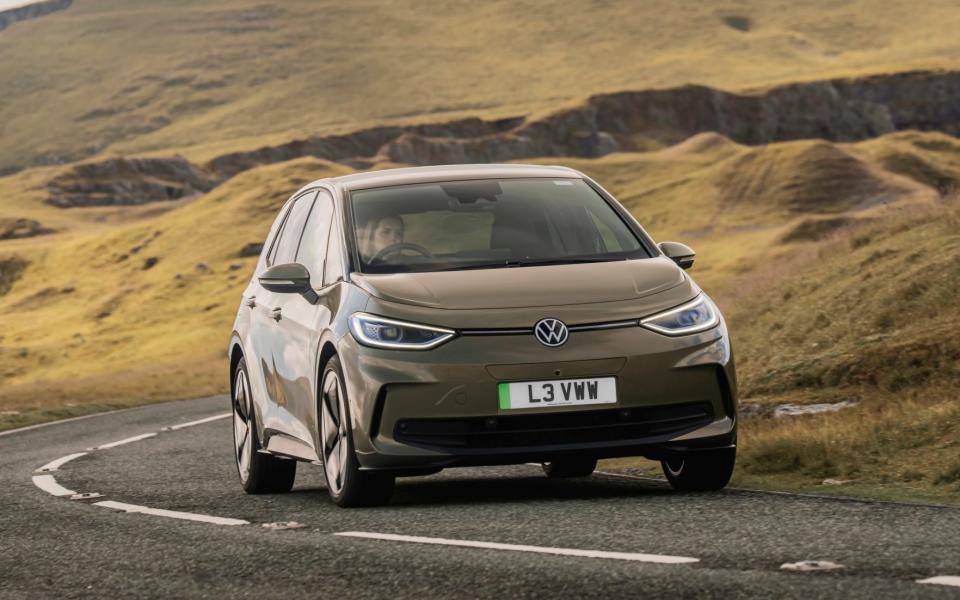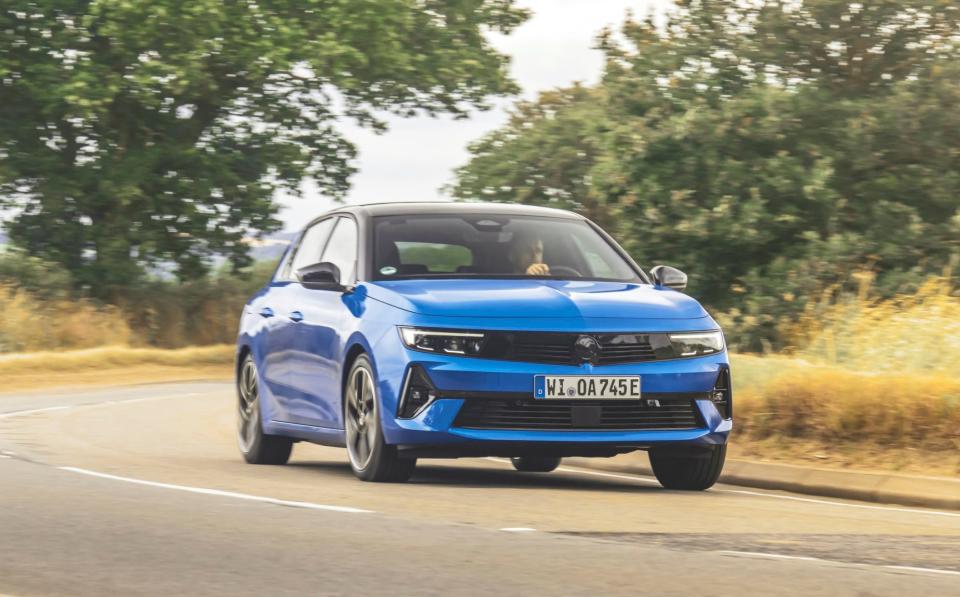Volkswagen ID.3 review: detail changes fix some flaws, but not all

You have to give Volkswagen some credit. Most car manufacturers, when they launch their facelifts, invite us hacks to a plush location somewhere in the Cotswolds and feed us on organic this and grass-fed that, with the aim of putting us in a good mood, in the vain hope that we’ll say nice things about their very lightly breathed-on cars as a result.
Volkswagen, by contrast, took us to the Earlstrees Industrial Estate in Corby. Now, while I’m sure Corby has many bucolic vistas to be enjoyed by any visitor prepared to unearth them, they aren’t immediately apparent from within the confines of the Earlstrees Industrial Estate.
This suggests that Volkswagen has not only every faith in the objectivity of the British motoring press, but also supreme confidence that its facelifted ID.3 is the bee’s knees.

And really, it has to be; the ID.3 was to be Volkswagen’s electric Golf; the car that would define its future and take it into its ‘third era’ – hence the name.
But its initial sheen has dulled as its price has risen and the full crumminess of its infotainment system has become apparent. And, partly as a consequence, sales have lagged, so that Volkswagen now finds itself playing catch-up.
This round of tweaks will have to breathe new life into the ID.3, not only if it’s to find favour in a growing pool of rivals – but also if it’s to avoid being viewed by history as a bit of a flop.
Pros
Beautiful ride and handling balance
Interior now feels much more upmarket
Spacious inside
Cons
User interfaces are better, but still flawed
Looks pricey next to some rivals
Heat pump is an optional extra
Identity parade
Where once you could have your ID.3 in any number of different permutations, today the range has slimmed somewhat. Pro and Pro S are the only versions available, the former with the same 58kWh battery as before and 120kW DC charging, and the latter with the larger 77kWh option and the ability to charge at 170kW.
It’s worth noting, too, that these are usable, rather than total figures, which is to say they don’t include the extra unusable margin of capacity manufacturers must build in to keep battery lives feasible.

What else has changed? Well, you’d have to put the old ID.3 next to the new one to spot the differences. There’s a new lower grille, for example, and less fussy detailing along the car’s flanks; the strip of black plastic under the windscreen has been done away with, and at the back, the previously fake lights on the boot lid now light up.
None of this is going to make you want to buy an ID.3 if you didn’t like it before. But the result of these many small changes is that the new car looks indefinably fresher and cleaner.
The greater change comes within. Previously, the ID.3 felt built down to a price, with cheap, scratchy materials, and these haven’t gone away entirely, but there has been a noticeable uplift in quality throughout. Plastics are more appealing, fabrics feel higher-quality, and little touches like the contrast stitching lend more of a premium feel.
While the ID.3 still wouldn’t rival a Mk7 Golf – Volkswagen’s high watermark – for perceived quality, it’s now better than it was (and at least the equal of the Golf Mk8).
Internal screening
But what about that touchscreen? Well, it’s better than it was, for sure. Boot-up times have been reduced, which means the time it takes for the system to get going so that you can turn on the windscreen demister or heated seats has been reduced to seconds, rather than whole minutes.
The menus have been rearranged to make them a touch less unintuitive, and the whole system feels more responsive and less laggy than before.

That’s not to say that all the faults have been eliminated, mind you. The system still has odd moments where it freezes, and the menus can still be a little tricky to find your way around given many of the icons look similar.
And of course, one of the biggest niggles – those touch-sensitive sliders, with their lack of illumination or haptic feedback, remains. As indeed do all the touch-sensitive pads throughout the car, that force you to take your attention away from the road for longer than would a simple button.
This is still not a feast of brilliant usability, in other words. It is a movement in the right direction, however, and given the system is capable of over-the-air updates, there’s a glimmer of hope that that movement will continue even after buyers have taken delivery.
In other areas, the ID.3 feels more like the eventual replacement for the Golf that it was supposed to be; it’s roomy in both the front and rear seats, there’s a good-sized boot and you get lots of storage space for odds and ends.

Beware if you choose the Pro S version, though; as before, if you want the larger battery, the ID.3 only gets four seats as standard.
There hasn’t been a huge uplift in price with this new model, either, though that doesn’t mean the ID.3 doesn’t feel expensive. When it first came out, the entry-level version would cost you around £32,000, and you could bash that down to sub-£30,000 thanks to the Government’s Plug-In Car Grant.
Currency exchange
Sadly, both the entry-level version and the grant have disappeared, which means the ID.3 now starts at a little over £37,000 for the Pro model tested here; the Pro S, meanwhile, goes for just shy of £43,000.
Consequently, the ID.3 still beats the Vauxhall Astra Electric, which isn’t as roomy and won’t go as far on a charge, on price. But a Citroën ë-C4 will cost you less and an MG 4 is even cheaper – to the point that even the top-spec, big battery model is more affordable than an entry-level ID.3.
Efficiency, at least, is on a par with these rivals at 4.3m/kWh, though that will likely plummet during the winter if you don’t tick the box for the optional £970 heat pump.

This is not a cheap car, then. But it is still a classy one to drive. There’s still the same sophisticated fluidity to the way the suspension finds its way over bumps, ironing them out while keeping the body well tied down, which is one of the ID.3’s best points. It feels like it’s taut, but not firm, holding itself up well yet glossing over the worst bumps, and it lopes along smoothly and quietly at motorway speeds, allowing miles to pass with ease.
Performance, meanwhile, is more than adequate; the ID.3 doesn’t tear your hair off, but it does feel effortless. And on the rare occasions you do want to take the twisty way home, the ID.3 isn’t a bad thing to be in for the purpose. Body control is excellent, there’s plenty of grip, and because the ID.3 is rear-wheel drive, feeding the power in simply nudges the nose round gently, rather than corrupting the steering as it does on some EVs.
Granted, the limited feel through the steering means you won’t be trading up into an ID.3 from your favourite hot hatch. But there’s more than enough talent here to give you the confidence to press on when you feel like it – and to enjoy the experience.
The Telegraph verdict
This round of updates doesn’t just keep the ID.3 current; it improves the car in some of the areas in which it formerly fell short. There are still issues here, but to give VW credit where it’s due, it seems to be listening, and trying to make the ID.3 into the car it really should have been from the start.
The trouble is, there are now far more rivals on the scene than there were when the ID.3 came out – and some of them offer more for less, which makes it harder to recommend.
For all that, though, this is still one of the sweetest electric cars out there to drive, lacking the stilted, ‘that’ll do’ dynamics of some of the EVs that are on sale today. It’s as pragmatic as you’d expect a VW hatchback to be, too, and now it even looks fresher and cleaner. So while it is still flawed, you’d be missing out if you were after a car like this and you didn’t at least try one.
The facts
On test: Volkswagen ID.3 Pro
Body style: Five-door Hatchback
On sale: now
How much? £37,115 on the road (range from £37,115)
How fast? 99mph, 0-62mph in 7.4sec
How economical? 4.3mpkWh (WLTP Combined)
Engine & gearbox: N/A
Electric powertrain: AC permanent-magnet synchronous motor with 58kWh (usable) battery, 120kW on-board charger, Type 2 charging socket
Electric range: 265 miles
Maximum power/torque: 201bhp/229lb ft
CO2 emissions: 0g/km (tailpipe), 26g/km (well-to-wheel)
VED: £0
Warranty: 3 years / 60,000 miles
Spare wheel as standard: No (not available)
The rivals
MG 4 SE Long Range
200bhp, 281 miles, £29,495 on the road

Check out the specs, and it’s hard to escape the conclusion that this version of the MG 4 was targeted at the ID.3 with a laser-like focus. Indeed, it makes the ID.3 look particularly pricey, with more range and a similar power figure for almost £10,000 less. Granted, the MG doesn’t feel as smart inside or out as the ID.3, but for that sort of a price difference, there’s an awful lot you could forgive.
Citroën ë-C4 Sense
134bhp, 219 miles, £31,495 on the road

You pay less for Citroën’s EV than you do for Volkswagen’s, but you also get less – less power, and less range. On the plus side, the lighter battery means very good efficiency, so while you’ll have to charge up more often on longer runs, it’ll actually cost you slightly less to run. And the ë-C4 is even smoother and more comfortable than the ID.3 – not to mention similarly roomy.
Vauxhall Astra Electric GS
154bhp, 258 miles, £39,795 on the road

Vauxhall has lopped a few hundred quid off the price of the Astra since we reviewed it, which makes it a touch more palatable. But this is still a car which lacks the power, space, range or comfort of the ID.3, yet costs considerably more. It’s not a bad car – it’s smart inside, and handles tidily – but the Astra is just too expensive to recommend.

 Yahoo News
Yahoo News 
